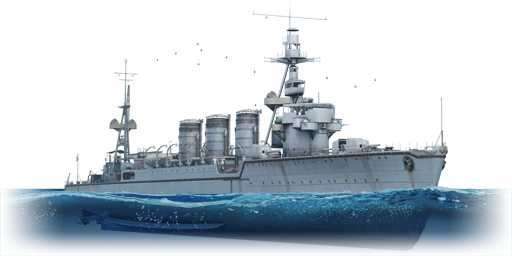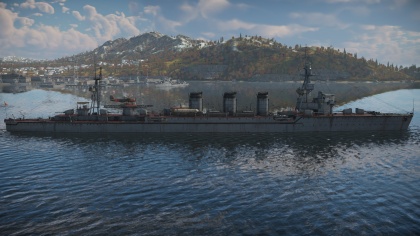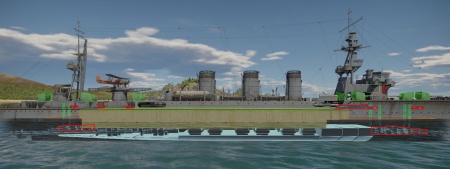IJN Tama
Contents
Description
The Kuma-class, IJN Tama, 1942 is a rank III Japanese light cruiser
with a battle rating of 5.0 (AB/RB/SB). It was introduced in Update 1.89 "Imperial Navy".
General info
Survivability and armour
IJN Tama is the weakest light cruiser when it comes to taking enemy fire, being unable to repel anything but destroyers in a direct, short-range gun battle. On top of having the lowest crew compliment among cruisers, it suffers from one major weakness: ammunition explosions.
Both: First-stage ammo stowage and its main ammunition storage (Charge/Shell/Ammunition storage rooms) are exposed to direct enemy fire. The main storage is somewhat protected by the 44.6 mm plate above it, however, it's above the waterline, allowing for lucky shells to get unimpaired into one of the rooms and blow it up. If the crew did not suffer particularly many casualties beforehand - ship can survive, however, such a blow is extremely severe, turning what otherwise would be a fresh ship, into a burning husk rapidly taking water in.
Moreover: The citadel armor is the weakest among cruisers, amounting to only 63 mm RHA. While on paper Emden, 1944 has only 50 mm, it's just for an internal plate, with a second 50 mm plate in front of it. Under battle conditions this gives her much better protection, in particular at a point-blank range, where she's completely immune to Kuma's 140 mm type 2 SAP shells. Kuma's citadel armor is enough to deflect only secondary armament (such as 3-inch Mark 10), HE shells from the main guns or certain low-penetration AP shells at a high angle of attack (such as 180 mm/60 B-1-K's PB-32 SAPCBC shell at angles of over 72°, or Kuma's own 140 mm type 2 SAP shells at any angle).
Mobility
Write about the ship’s mobility. Evaluate its power and manoeuvrability, rudder rerouting speed, stopping speed at full tilt, with its maximum forward speed and reverse speed.
Armament
Primary armament
Provide information about the characteristics of the primary armament. Evaluate their efficacy in battle based on their reload speed, ballistics and the capacity of their shells. Add a link to the main article about the weapon: {{main|Weapon name (calibre)}}.
Broadly describe the ammunition available for the primary armament, and provide recommendations on how to use it and which ammunition to choose.
Secondary armament
Some ships are fitted with weapons of various calibres. The secondary armament is defined as the weapon chosen with the control Select secondary weapon. Evaluate the secondary armament and give advice on how to use them. Describe the ammunition available for the secondary armament. Provide recommendations on how to use them and which ammunition to choose. Remember that anti-air armament, even heavy calibre weapons, belong in the next section.
If there is no secondary armament, remove this section.
Anti-aircraft armament
An important part of the ship’s armament responsible for air raid defence. Anti-aircraft armament is defined by the weapon chosen with the control Select anti-aircraft weapons. Talk about the ship’s anti-air cannons and machine guns, the number of guns and their positions, their effective range, and about their overall effectiveness – including against surface targets.
If there is no anti-aircraft artillery, remove this section.
Torpedo armament
Torpedoes launchers are standard equipment on many ships and boats. Torpedoes are a significant means of defeating an opponent. Evaluate the position of the torpedo launchers, discuss the ammunition available, firing specifics such as dead zones, features of the torpedoes themselves, etc.
If there is no torpedo armament, remove this section.
Special armament
Depth charges, mines, rocket launchers and missiles are also effective in skilled hands and can take an off-guard opponent by surprise. Evaluate the ammunition of this type of armament and rate its performance in combat.
Usage in battles
Describe the technique of using this ship, the characteristics of her use in a team and tips on strategy. Abstain from writing an entire guide – don’t try to provide a single point of view, but give the reader food for thought. Talk about the most dangerous opponents for this vehicle and provide recommendations on fighting them. If necessary, note the specifics of playing with this vehicle in various modes (AB, RB, SB).
Pros and cons
Pros:
- Able to reload torpedoes in battle
- High speed
- Very decent fire power for the main caliber
Cons:
- Poor AA armament
History
Due to the expectation that the Tenryū-class cruiser wouldn’t perform to the satisfaction of the naval command in its role of leader and the appearance of newer and faster destroyer types, with which the Tenryū wasn’t able to keep up with, the shortcomings of the Japanese small cruiser concept became evident. These shortcomings were further emphasized with the advent of the large American Omaha-class light cruiser, capable of easily outgunning the Tenryū-class.
In response to this, Japanese shipbuilders revised Tenryū’s design and developed a new, larger version of the ship with increased speed, range and firepower. This new successor design would become known as the Kuma-class light cruiser. With the design being accepted, outstanding plans for the construction of the four remaining Tenryū-class light cruisers, as well as three other cruisers, were cancelled, while an order to construct five Kuma-class light cruisers was issued instead.
Kuma, the lead ship of her class, was laid down in August 1918, launched in July 1919 and subsequently entered service with the IJN the following year, in August of 1920. Immediately after her commissioning, Kuma was deployed as part of the Japanese intervention in Siberia against Bolshevik forces.
During the early 1930s, Kuma underwent a significant refit and later took part in hostilities during the Second Sino-Japanese War, patrolling off the coast of China and assisting in landing operations.
Following the attack on Pearl Harbor, Kuma participated in the Invasion of the Philippines and would remain stationed there until August 1942. After a brief refit in September, Kuma joined the Dutch East Indies and New Guinea campaigns, being tasked with transporting troops and patrolling the local waters until late 1943.
In January 1944, Kuma came under torpedo attack from the British submarine HMS Tally-Ho, shortly after departing Penang. Kuma suffered two hits, with the resulting damage and subsequent depth charge detonations sealing the ship’s fate. Kuma was later struck from navy records in March 1944.
- From Devblog
Media
Excellent additions to the article would be video guides, screenshots from the game, and photos.
See also
Links to the articles on the War Thunder Wiki that you think will be useful for the reader, for example:
- reference to the series of the ship;
- links to approximate analogues of other nations and research trees.
External links
| Japan light cruisers | |
|---|---|
| Kuma-class | IJN Tama |
| IJN Yubari* | |
| Nagara-class | IJN Isuzu |
| Sendai-class | IJN Sendai |
| Agano-class | IJN Agano |
| Mogami-class | IJN Mikuma · IJN Suzuya |
| * Unique ship | |






